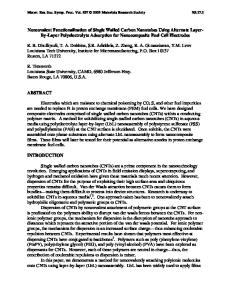A universal functionalization strategy for biomimetic nanochannel via external electric field assisted non-covalent inte
- PDF / 2,462,186 Bytes
- 8 Pages / 612 x 808 pts Page_size
- 58 Downloads / 301 Views
A universal functionalization strategy for biomimetic nanochannel via external electric field assisted non-covalent interaction Yunfei Teng1,2, Xiang-Yu Kong1 (), Pei Liu1,2, Yongchao Qian1, Yuhao Hu1, Lin Fu1,2, Weiwen Xin1,2, Lei Jiang1,2, and Liping Wen1,2 () 1
CAS Key Laboratory of Bio-inspired Materials and Interfacial Science, Technical Institute of Physics and Chemistry, Chinese Academy of Sciences, Beijing 100190, China 2 School of Future Technology, University of Chinese Academy of Sciences, Beijing 100049, China © Tsinghua University Press and Springer-Verlag GmbH Germany, part of Springer Nature 2020 Received: 8 July 2020 / Revised: 21 September 2020 / Accepted: 14 October 2020
ABSTRACT Biological ion channels, as fundamental units participating in various daily behaviors with incredible mass transportation and signal transmission, triggered booming researches on manufacturing their artificial prototypes. Biomimetic ion channel with the nanometer scale for smart responding functions has been successfully realized in sorts of materials by employing state-of-art nanotechnology. Ion track-etching technology, as crucial branches of fabricating solid-state nanochannels, exhibits outstanding advantages, such as easy fabrication, low cost, and high customization. To endow the nanochannel with smart responsibility, various modification methods are developed, including chemical grafting, non-covalent adsorption, and electrochemical deposition, enriching the reservoir of accessible stimuli-responses combinations, whereas were limited by their relatively lengthy and complex procedure. Here, based on the electric field induced self-assembly of polyelectrolytes, a universal customizable modifying strategy has been proposed, which exhibits superiorities in their functionalization with convenience and compatibility. By using this protocol, the channels’ ionic transport behaviors could be easily tuned, and even the specific ionic or molecular responding could be realized with superior performance. This strategy surely accelerates the nanochannels functionalization into fast preparing, high efficiency, and large-scale application scenarios.
KEYWORDS biomimetic, ionic nanofluidics, ionic rectification, solid-state nanopore, nanochannel
1
Introduction
Protein channels play vital roles in various daily behaviors, especially environmental perceptions, which rely on different specific responsive categories. Protein ion nanochannels [1, 2], as a group of membrane proteins undertaking corresponding ions transportation, count on polypeptides with well-designed amino acidic sequences and spatial configurations. The unique functions of wild membrane protein and their artificial mutants [3, 4] have introduced a research upsurge of various related research fields, especially molecular recognition and biomolecular sequencing [5, 6]. However, their fundamental elements, polypeptides, which inherited from their original prototypes, restricted their wider application owing to the limited environmental tolerance and sophisticated
Data Loading...











